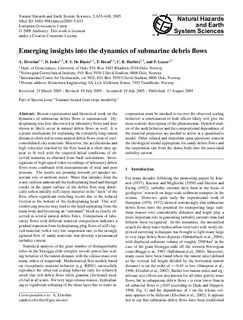| dc.contributor.author | Elverhøi, Anders | |
| dc.contributor.author | Issler, Dieter | |
| dc.contributor.author | De Blasio, Fabio V. | |
| dc.contributor.author | Ilstad, Trygve | |
| dc.contributor.author | Harbitz, Carl Bonnevie | |
| dc.contributor.author | Gauer, Peter | |
| dc.date.accessioned | 2017-01-03T10:10:22Z | |
| dc.date.available | 2017-01-03T10:10:22Z | |
| dc.date.issued | 2005 | |
| dc.identifier.issn | 1684-9981 | |
| dc.identifier.uri | http://hdl.handle.net/11250/2426114 | |
| dc.description.abstract | Recent experimental and theoretical work on the dynamics of submarine debris flows is summarized. Hydroplaning was first discovered in laboratory flows and later shown to likely occur in natural debris flows as well. It is a prime mechanism for explaining the extremely long runout distances observed in some natural debris flows even of over-consolidated clay materials. Moreover, the accelerations and high velocities reached by the flow head in a short time appear to fit well with the required initial conditions of observed tsunamis as obtained from back-calculations. Investigations of high-speed video recordings of laboratory debris flows were combined with measurements of total and pore pressure. The results are pointing towards yet another important role of ambient water: Water that intrudes from the water cushion underneath the hydroplaning head and through cracks in the upper surface of the debris flow may drastically soften initially stiff clayey material in the "neck" of the flow, where significant stretching occurs due to the reduced friction at the bottom of the hydroplaning head. This self-reinforcing process may lead to the head separating from the main body and becoming an "outrunner" block as clearly observed in several natural debris flows. Comparison of laboratory flows with different material composition indicates a gradual transition from hydroplaning plug flows of stiff clay-rich material, with a very low suspension rate, to the strongly agitated flow of sandy materials that develop a pronounced turbidity current.
Statistical analysis of the great number of distinguishable lobes in the Storegga slide complex reveals power-law scaling behavior of the runout distance with the release mass over many orders of magnitude. Mathematical flow models based on viscoplastic material behavior (e.g. BING) successfully reproduce the observed scaling behavior only for relatively small clay-rich debris flows while granular (frictional) models fail at all scales. For very large release masses, hydroplaning or significant softening of the shear layer due to water incorporation must be invoked to recover the observed scaling behavior; a combination of both effects likely will give the most realistic description of the phenomenon. Detailed studies of the neck behavior and the compositional dependence of the material properties are needed to arrive at a quantitative model. Other related and important open questions concern the rheological model appropriate for sandy debris flows and the suspension rate from the dense body into the associated turbidity current. | nb_NO |
| dc.language.iso | eng | nb_NO |
| dc.rights | Navngivelse-Ikkekommersiell-DelPåSammeVilkår 4.0 Internasjonal | * |
| dc.rights.uri | http://creativecommons.org/licenses/by-nc-sa/4.0/deed.no | * |
| dc.title | Emerging insights into the dynamics of submarine debris flows | nb_NO |
| dc.type | Journal article | nb_NO |
| dc.rights.holder | Creative Commons Attribution-NonCommercial-ShareAlike 2.5 License. | nb_NO |
| dc.source.pagenumber | 633-648 | nb_NO |
| dc.source.volume | 5 | nb_NO |
| dc.source.journal | Natural Hazards and Earth System Sciences | nb_NO |

